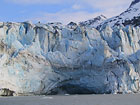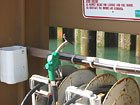

 | |||||||
|
|
Journals 2004/2005Leesa Wingo
July 15, 2004 We headed up the West arm of Glacier Bay, past a whale that was just lolling in the water. It was exhibiting unusual behavior, so Lisa called it in to alert Janet, the Fish and Game whale expert. We were to watch the strengths of the exhalation "blows" to diagnose if the whale was in distress or just sleeping. There was no gear entangled, and the breathing seemed to be steady and consistent. A second smaller whale circled around the first, never leaving it - a mate? A calf? A friend? We saw no problems so we left. Other interesting things on the way up the bay were the magnetic anomaly mountain was right where the two arms of the bay split. It might be a giant magnetite or iron deposit. Another geological phenomenon was a whole hillside that was sloughing off. Geologists predict the tsunami would be around sixty feet tall and would wipe out the ranger raft several miles away. All small craft would be demolished and a cruise ship would be tossed around badly if they were in the area. (http://pubs.usgs.gov/of/2003/ofr-03-100/ and http://geopubs.wr.usgs.gov/open-file/of03-411/) (Click on thumbnail below for full version pop-up) Sampling with the CTD began at the top of the bay at the Grand Pacific Glacier. Lisa maneuvered the boat between ice chunks and was able to take a reading quite close to the face of the glacier. The Grand Pacific Glacier has surged and retreated several times in the last century. In 1925, it receded to the other side of the Canadian border, giving ocean access to Canada. Canada had to make a plan in case the glacier recedes and permanent access is available. (Click on thumbnail below for full version pop-up) We sampled several sites using the CTD and I had three turns at coiling the line. 260m., 300m. and 300m. By the third attempt I felt better and the boat was even rocking! The key is to bend the knees and grip the bucket with your knees and to reach high with your hands. We returned to dock about 8:00, where we tried to refuel in the evening, but the fuel dock was not in service. I spent time taking pictures of the barn swallows that made a nest right above the fuel pump. I question what the fumes have done to the development of the birds! (Click on thumbnails below for full version pop-up) No luck with the gasoline, so Lisa set the time to meet the next day for 6:30 a.m. Return to Journals Index |
||||||



